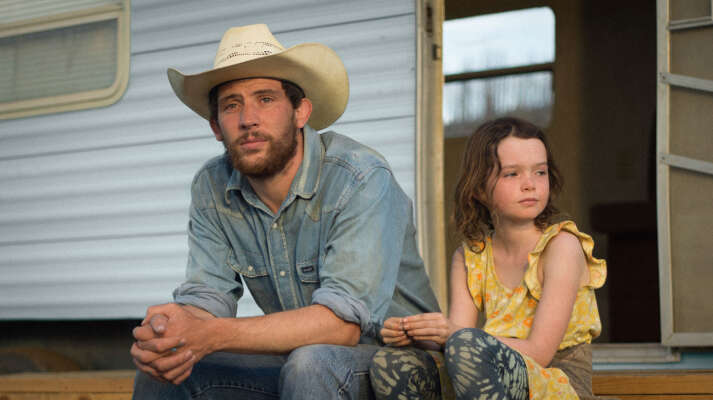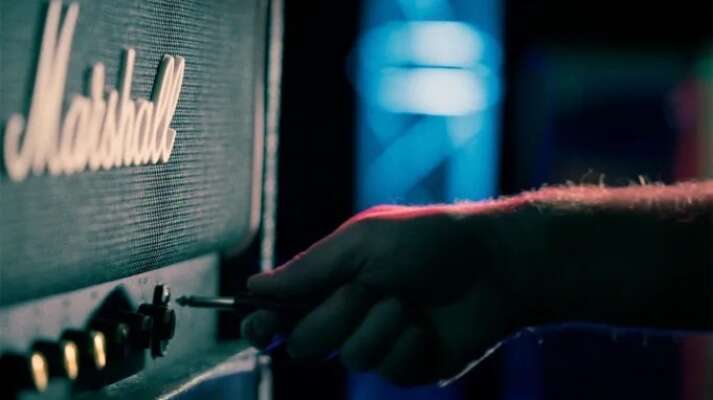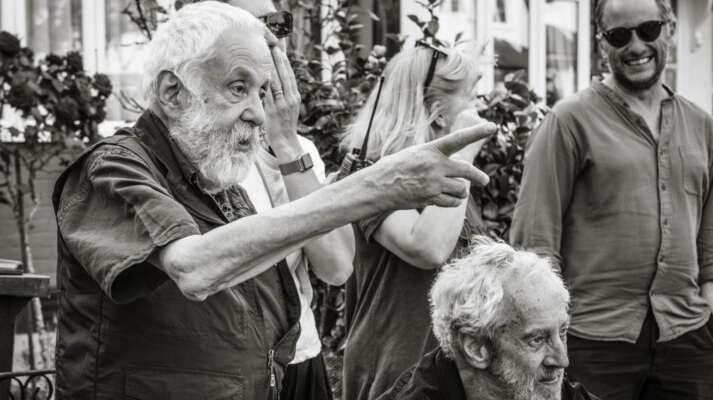10 Films Behind Alexander McQueen's Fashion
From The Birds to Chitty Chitty Bang Bang, Alexander McQueen wove his love of cinema into his fantastic shows
10 Films Behind Alexander McQueen's Fashion
Written by Peter Bowen
Ian Bonhôte and Peter Ettedgui's documentary McQueen explores the creative life and imagination of fashion designer Alexander McQueen. In addition to changing the face of fashion, McQueen's spectacular events turned runway conventions upside down by making the presentation of his seasonal collections a must-see theatrical event. "His shows were happenings," explains writer and co-director Ettedgui. "He was a true showman in a way the fashion world hadn't seen." McQueen's longtime collaborator Sebastian Pons believes that he "created theater that brought you into his world-whether you liked it or not." Stitching together pop culture and Scottish folklore, personal nightmares and cutting-edge technology, his runway shows became a new form of theatrical expression, one that demanded audiences have an emotional reaction. Perhaps his biggest influence, however, was cinema. ''Films always inspire me," explains McQueen in The New York Times. "I have used them as visual backdrops in my shows, as they instill such an incredible atmosphere of emotion.'' One can see just how wide-ranging his cinematic influences are in Kyle Turner's short film Blood Beneath Skin: Alexander McQueen and Cinema. We look here at how ten films inspired his different shows.

Autumn/Winter 1993 "Taxi Driver" | Martin Scorsese's Taxi Driver
In his first show after graduating from London's leading fashion school, Central Saint Martins, McQueen honored Martin Scorsese's iconic film Taxi Driver. With little money for materials, McQueen turned his poverty to his advantage, reusing convention materials, like latex and Clingfilm, and introducing new styles, like the low-riding pants that would become McQueen's hallmark "Bumster" look. Inspired by the film, especially the scene where Travis Bickle (Robert De Niro) shaves his head into a Mohawk, McQueen printed the poster's iconic image onto fabric. Many noted that calling this early show "Taxi Driver" might strike a personal note, since his father, Ronald McQueen, had actually been a taxi driver.
 The Birds" title="Above, "The Birds;" Below, Tippi Hedren in The Birds">
The Birds" title="Above, "The Birds;" Below, Tippi Hedren in The Birds">Spring/Summer 1995 "The Birds" | Alfred Hitchcock's The Birds
Having loved many of Hitchcock's classic films as a child, McQueen brought the master filmmaker's unique suspense and style into his shows. His Spring/Summer 1995 show "The Birds" took its name and much of his creative energy from Hitchcock's 1963 film of the same name. The stylish Tippi Hedren makes an ill-fated trip to Northern California's Bodega Bay to visit a man she has just met when the local birds mysteriously start attacking the human citizens of that coastal town. Simon Ungless, a close friend from Central Saint Martins, explains how the film's mix of pencil skirts and human peril was "All very McQueen." He explains, "Tippi is made vulnerable through the hobbling effect of her clothes in the movie-this beautiful, sexy woman placed into a different environment and put at extreme risk but winning in the end." To amplify that effect, McQueen procured milky white contact lenses for the models to wear, an effect that hairdresser Eugene Souleiman recalls made it look as if "they had been attacked by birds, with those lenses in their eyes." Ten years later, McQueen returned to Hitchcock with his Autumn/Winter 2005 collection "The Man Who Knew Too Much ," an ode to sixties glamor with a Vertigo inspired invitation to a Rear Window set.

Spring/Summer 1996 "The Hunger" | Tony Scott's The Hunger
McQueen's love of the dark side came out in his appreciation of horror. His show The Hunger brought to the runway Tony Scott's 1983 cult vampire film of the same name with Catherine Deneuve, Susan Sarandon, and David Bowie. From its blood-lit backdrops to the bloody handprints on the models' shirts, the show touched on the vampiric. Perhaps its most stunning nod to the film's themes of mortality and eternal life came from a model wearing a transparent acrylic bodice filled with living, squirming worms-a reminder of what we humans are fated for and what vampires avoid.

Givenchy Fall/Winter 1998 | Ridley Scott's Blade Runner
In his Fall/Winter 1998 show for Givenchy, McQueen went back to the future with a collection that referenced Ridley Scott's 1982 sci-fi noir classic Blade Runner. Costume designer Michael Kaplan, who created Sean Young's iconic shoulder-padded outfits for the film, noted that of all the designers who've been influenced by Blade Runner, only McQueen got it right. His Givenchy show "was beautifully done and original in its own right," explains Kaplan. "Other people say they are referencing it, but I don't see anything interesting or new in the finished product."
 Psycho" title="Above, "No. 13;" Below, Janet Leigh in Psycho">
Psycho" title="Above, "No. 13;" Below, Janet Leigh in Psycho">Spring/Summer 1999 "No. 13" | Alfred Hitchcock's Psycho
McQueen's thirteenth collection emphasized a heady mix of the hand-made and the robotic. Under the beat of the Beastie Boys, models presented a richly detailed collection inspired by the 19th century Arts and Crafts Movement, an aesthetic that directly challenged the mechanization of the emerging factory system. The show's denouement, however, provided a surreal challenge to the opposition of craft and machine-made. The former ballerina Shalom Harlow is turned mechanically about as she is slashed with streaks of paint from two industrial robots on either side of her. Biographer Andrew Wilson describes the mechanical shower/assault as "a tender tribute to Alfred Hitchcock's Psycho."

Autumn/Winter 1999 "The Overlook" | Stanley Kubrick's The Shining
The title of McQueen's "The Overlook" refers to the snowed-in hotel in Stephen King's The Shining, which Stanley Kubrick adapted into a film in 1980. As one of McQueen's favorite directors, Kubrick's icy elegance and chilly precision matched the designer's own meticulous craftsmanship. In the show, with the sounds of howling winds and wolves on the soundtrack, models traipsed through a wintery world enclosed inside a giant Lucite box, a vision that seems to refer as much to the icy maze in front of the hotel as to the building itself. At one point, two red-haired twin models wearing identical grey outfits walk out hand in hand, a tailored nod to the spooky blue-dressed twins in Kubrick's film. Even the clothes shimmered with an icy elegance from a model encased in crystals to a glittering aluminum corset. For McQueen, the show touched on "the romantic side of the film."

Autumn/Winter 2001 "What A Merry-Go-Round" | Ken Hughes' Chitty Chitty Bang Bang
Set in an old bus depot, "What A Merry-Go-Round" fulfilled McQueen's quip that "Life to me is a bit of a Brothers Grimm fairytale." Incorporating the voice of the creepy child catcher from the childhood classic Chitty Chitty Bang Bang on the soundtrack, McQueen spoke to the darker side of childhood. With a carousel of latex-covered horse on stage, the later part of the show opened up to reveal a world of broken toys and women in elegant gowns all done up with scary clown hair and makeup.
 They Shoot Horses, Don't They?" title="Above, "Deliverance;" Below, Jane Fonda in They Shoot Horses, Don't They?">
They Shoot Horses, Don't They?" title="Above, "Deliverance;" Below, Jane Fonda in They Shoot Horses, Don't They?">Spring/Summer 2004 "Deliverance" | Sydney Pollack's They Shoot Horses, Don't They?
McQueen's 2004 "Deliverance" reimagines the desperate dance marathon in Sydney Pollack's They Shoot Horses, Don't They? as a fashion show. Choreographed by Michael Clark, the models and their partners race around a 19th-century dance hall ending in a frenzy of fatigue with model Karen Elson dancing herself to death. Many wondered if this spectacle of exhaustion wasn't also a personal comment by McQueen about his own unending marathon of designing collections and putting on show.
 Danse Serpentine" title="Above, "The Widows of Culloden;" Below, Lumière brothers' Danse Serpentine">
Danse Serpentine" title="Above, "The Widows of Culloden;" Below, Lumière brothers' Danse Serpentine">Autumn/Winter 2006 "The Widows of Culloden" | Lumière brothers' Danse Serpentine
Returning to his fascination with Scottish history and tradition-first brought up in his groundbreaking 1995 "Highland Rape"-McQueen explores the themes of loss and melancholy in his 2006 show "The Widows of Culloden." While directly inspired by the 1746 Battle of Culloden, in which several thousand Scotsmen were killed, the show is dedicated to McQueen's close friend Isabella Blow, who would die less than a year later. The show's haunted sensibility manifested in the climax that appeared after all the models had left the stage. To a soundtrack of Itzhak Perlman playing the plaintive violin score from Schindler's List, a holographic apparition of Kate Moss appeared in a pyramid on stage. Shot by Baillie Walsh and directed by McQueen, the film directly recalls the Lumière brothers' 1896 film Danse Serpentine with the dancer Loie Fuller.
 Barry Lyndon" title="Left, "Sarabande;" Right, Marisa Berenson in Barry Lyndon">
Barry Lyndon" title="Left, "Sarabande;" Right, Marisa Berenson in Barry Lyndon">Spring/Summer 2007 "Sarabande" | Stanley Kubrick's Barry Lyndon
For his 2007 collection "Sarabande," McQueen returned to one of his favorite directors, Stanley Kubrick, and his 1975 period pieceBarry Lyndon. Rather than speak to the film's picaresque plot, which was adapted from a William Thackeray novel, McQueen's show captures the languid elegance of Kubrick's film. The show's title refers to Handel's stately "Sarabande," the iconic piece of music which plays under Barry Lyndon's title sequence, as well as throughout the film. In McQueen's show, a giant chandelier hangs above a string quartet playing Handel's signature piece, as well as a baroque take on The Rolling Stones' "Paint It Black," as models show off a collection of romantic, 19th-century influenced outfits.


